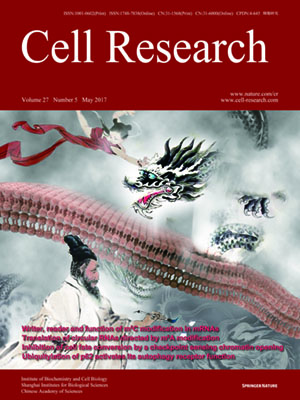
Volume 27, No 5, May 2017
ISSN: 1001-0602
EISSN: 1748-7838 2018
impact factor 17.848*
(Clarivate Analytics, 2019)
Volume 27 Issue 5, May 2017: 626-641 | Open Access
ORIGINAL ARTICLES
Extensive translation of circular RNAs driven by N6-methyladenosine
Yun Yang1,2,3,4,*, Xiaojuan Fan2,*, Miaowei Mao4,5,*, Xiaowei Song2,4, Ping Wu6,7, Yang Zhang8, Yongfeng Jin1, Yi Yang5, Lingling Chen8, Yang Wang9, Catherine CL Wong6,7, Xinshu Xiao3 and Zefeng Wang2,4
1Institute of Biochemistry, College of Life Sciences, Zhejiang University at Zijingang, Zhejiang, Hangzhou, Zhejiang 310058, China
2CAS Key Lab for Computational Biology, CAS Center for Excellence in Molecular Cell Science, CAS-MPG Partner Institute for Computational Biology, Shanghai Institute for Biological Sciences, Chinese Academy of Sciences, Shanghai 200031, China
3Department of Integrative Biology and Physiology and the Molecular Biology Institute, UCLA, Los Angeles, CA 90095, USA
4Department of Pharmacology, University of North Carolina at Chapel Hill, Chapel Hill, NC 27599, USA
5Synthetic Biology and Biotechnology Laboratory, State Key Laboratory of Bioreactor Engineering, School of Pharmacy, East China University of Science and Technology, Shanghai, China
6National Center for Protein Science, Institute of Biochemistry and Cell Biology, Shanghai Institutes for Biological Sciences, Chinese Academy of Sciences, Shanghai 200031, China
7Shanghai Science Research Center, Chinese Academy of Sciences, Shanghai, 201204, China
8Institute of Biochemistry and Cell Biology, Shanghai Institute for Biological Sciences, Chinese Academy of Sciences, Shanghai 200031, China
9Institute of Cancer Stem Cell, Dalian Medical University, Dalian, Liaoning 116044, China
Correspondence: Zefeng Wang,(wangzefeng@picb.ac.cn)
Extensive pre-mRNA back-splicing generates numerous circular RNAs (circRNAs) in human transcriptome. However, the biological functions of these circRNAs remain largely unclear. Here we report that N6-methyladenosine (m6A), the most abundant base modification of RNA, promotes efficient initiation of protein translation from circRNAs in human cells. We discover that consensus m6A motifs are enriched in circRNAs and a single m6A site is sufficient to drive translation initiation. This m6A-driven translation requires initiation factor eIF4G2 and m6A reader YTHDF3, and is enhanced by methyltransferase METTL3/14, inhibited by demethylase FTO, and upregulated upon heat shock. Further analyses through polysome profiling, computational prediction and mass spectrometry reveal that m6A-driven translation of circRNAs is widespread, with hundreds of endogenous circRNAs having translation potential. Our study expands the coding landscape of human transcriptome, and suggests a role of circRNA-derived proteins in cellular responses to environmental stress.
10.1038/cr.2017.31
FULL TEXT | PDF
Browse 1791


